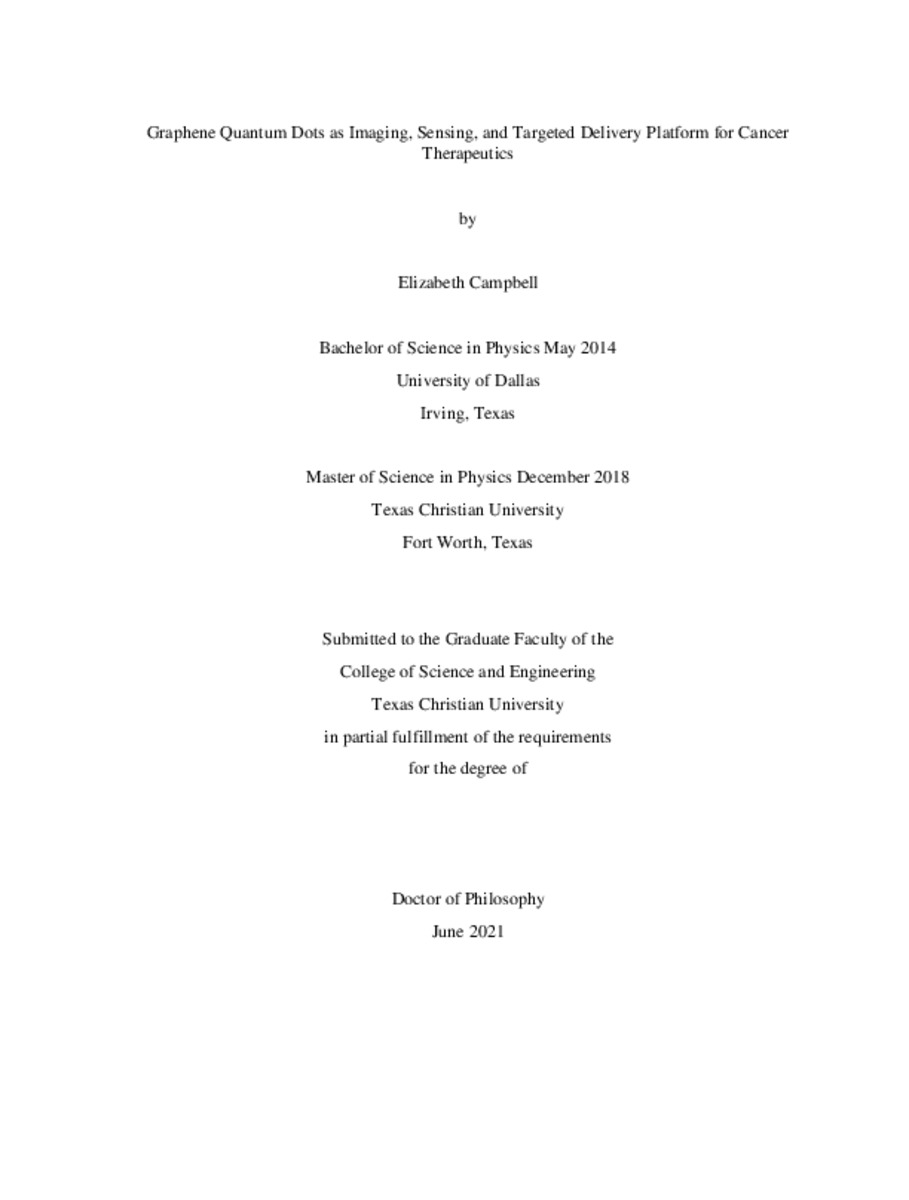Graphene Quantum Dots as Imaging, Sensing, and Targeted Delivery Platform for Cancer TherapeuticsShow full item record
| Title | Graphene Quantum Dots as Imaging, Sensing, and Targeted Delivery Platform for Cancer Therapeutics |
|---|---|
| Author | Campbell, Elizabeth |
| Date | 7/7/2021 |
| Genre | Dissertation |
| Degree | Doctor of Philosophy |
| Abstract | The objective of this research is to develop, optimize and test graphene quantum dots (GQDs) as imaging, sensing, and drug delivery platform. GQDs possess properties beneficial for molecular drug delivery/imaging/sensing applications. GQDs exhibit pH-dependent fluorescence in the visible, is water soluble and has a substantial platform for functionalization with multiple therapeutics. GQDs are beneficial for their biocompatibility, small size (< 5 nm), ease in synthesis, and high yield fluorescence in the visible and near-infrared. We explore the imaging and sensing capabilities of GQDs in vitro via their intrinsic fluorescence, pH-dependence of their emission for detection of acidic cancerous environments, and capabilities for in vitro transport of therapeutics. As a result, we expect GQDs to be successful multifunctional agents for imaging, sensing, and drug delivery advancing scientific approach to cancer treatment and therapeutics. This work then develops a new multifunctional biocompatible anticancer nanoformulation to provide targeted image-guided cancer-selective therapeutics. It consists of three active covalently bound components: (1) biocompatible nitrogen-doped graphene quantum dots (GQDs) as a multifunctional delivery and imaging platform, (2) hyaluronic acid (HA) unit targeted to the CD44 receptors on a variety of cancer cells, and (3) oxidative stress-based cancer-selective ferrocene (Fc) therapeutic. The biocompatible GQD platform synthesized from glucosamine exhibits high-yield intrinsic fluorescence. It is utilized for tracking Fc-GQD-HA formulation in vitro indicating internalization enhancement in HeLa cells targeted by the HA over non-cancer HEK-293 cells not overexpressing CD44 receptor. Fc-GQD-HA, non-toxic at 1 mg/mL to HEK-293 cells, induces cytotoxic response in HeLa enhanced over time, while therapeutic ROS generation by Fc-GQD-HA is ~3 times greater than that of Fc alone. This outlines the targeted delivery, imaging, and cancer-specific treatment capabilities of the new Fc-GQD-HA formulation enabling desired cancer-focused nanotherapeutic approach. |
| Link | https://repository.tcu.edu/handle/116099117/48026 |
| Department | Physics and Astronomy |
| Advisor | Naumov, Anton V. |
Files in this item
This item appears in the following Collection(s)
- Doctoral Dissertations [1514]
© TCU Library 2015 | Contact Special Collections |
HTML Sitemap



